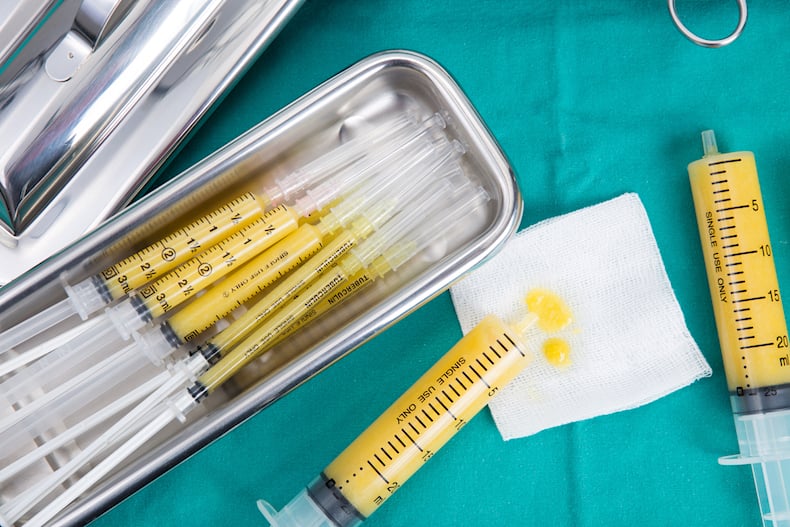What is Fat Transfer?

Fat transfer, also known as fat grafting or autologous fat transfer, is the process of using a patient’s own fat to increase the volume of fat in another area of the body. Because autologous fat comes from the patient’s own body, the body will not reject it. It is a minimally invasive skin rejuvenation and anti-aging procedure that restores subtle volume and a better shape to the face and body. The fat is extracted using a small liposuction cannula, then injected into the new part of the body using very small blunt tipped cannulas. The most common areas where fat is taken from are the stomach, thighs, and hips. Fat transfer is minimally invasive, and the recovery time is short.
The procedure is commonly utilized to reconstruct soft tissue defects caused by aging, trauma, chronic wounds and cancer resection. It is a powerful technique that also allows us to treat atrophy enhanced by augmentation, something we have previously been unable to do in this natural fashion. This has been one of the most important advances in esthetic surgery in several decades. Properly performed, the addition of fat to areas of the face that have atrophied due to age or disease can produce a significant and sustained improvement in appearance unattainable by other means. For example, at Modern Surgical Arts of Denver, when a facelift is performed by our board certified cosmetic surgeon, Dr. Kamran Dastoury, in conjunction with fat injections, not only will the excess skin laxity be corrected with the lift, but a more natural appearance can be achieved by using the patient’s own fat cells to correct the loss of facial volume. Call our office in Highlands Ranch for information or to schedule a consult: Highlands Ranch Office Phone Number 303-470-3400.
What are Stem Cells and how are they used in Fat Transfer?
Stem cells are naturally occurring and unique in that they have to ability to self-renew and transform themselves into any other type of cell–skin or muscle, for example. When injected, they enhance tissue healing and create new blood vessels. In the case of fat transfer, they fill out hollow areas and improve the texture and appearance of your skin. They also continue to improve the appearance of your skin long after the initial procedure, which provides results that last longer.
Why should I consider Fat Transfer?
Fat transfer is most commonly performed for cosmetic purposes. It is a more natural option for volume enhancement. It can also be more economical for patients who need multiple syringes of facial fillers. On the face, fat transfer is used to correct age-related facial atrophy, a normal part of the normal aging process. With increasing age, fat is lost from the temples, around the eyes and mouth and in the mid portion of the cheek.
Is Fat Superior to Filler?
No, they are different. Fat has some advantage over dermal fillers, especially as a complementary procedure to face and neck lifts. For example, facial fillers can range between $500-700 per syringe and last between 12-18 months. But with fat cell transfer we can get up to 20-30 syringes for a full face rejuvenation procedure. During surgery it is possible to harvest the patient’s own fat in sufficient quantities to treat the entire face. Secondly, a fat transfer procedure may be done safely under a local anesthesia and laughing gas (nitrous oxide) in an outpatient setting without the risk of general anesthesia.
Fat transfer also differs from fillers in that fat feels natural feeling to the touch, and moves moves with the patients’ anatomy. It can also improve the esthetics of the overlying skin tone, and best of all there is no risk of patient allergy. Not all the fat transferred will survive and, depending on which location we are transferring to, survival rates can be up to 80-90%. However, it is important to select a physician that has experience with the techniques that achieve the best long term results. At Modern Surgical Arts of Denver we strive for these results and always discuss with patients the need for adding additional fat in multiple layers over a period of time for a more natural and predictable result.
How is the procedure performed?
At Modern Surgical Arts of Denver, Drs. Dastoury or Zwiebel uses advanced techniques for harvesting the fat in a sterile environment with minimal stem cell contact. The fat is harvested using a very fine needle-like cannula to gently perform liposuction. The fat naturally contains some stem cells, which are harvested in the process along with the fat cells. Nothing artificial is added nor biologically manipulated within the harvested fat. The fat is then injected back into the face within a few minutes of the harvest procedure using fine blunt tipped cannulas developed to minimize injury to the living cells.
What areas can Fat Grafting be performed on?
At Modern Surgical Arts of Denver, Drs. Dastoury or Zwiebel will work with patients to customize an aesthetic treatment plan that is tailored to meet the needs of each individual. Thus, as areas in need of treatment will vary, planning fat injections requires looking at the face with the eye of a “sculptor”. Any area successfully treatable with non-autologous injectable fillers is potentially treatable with fat injections. For the face, these areas include — but are not limited to — the temples, brow, glabella, lower eyelids (tear trough), cheeks, mid-face, lips, peri-oral, nasolabial crease, and jawline.
Additionally, fat transfer can also be used for other areas around the body for enhancing one’s own natural appearance such as buttock augmentation and breasts.
For men, we can also use utilize the fat cells to augment the jawline, pectoralis muscle (chest muscles), deltoids, and biceps to achieve a more masculine appearance.
Interested? Questions? Please call us in Highlands Ranch for assistance! Highlands Ranch Office Phone Number 303-470-3400.


